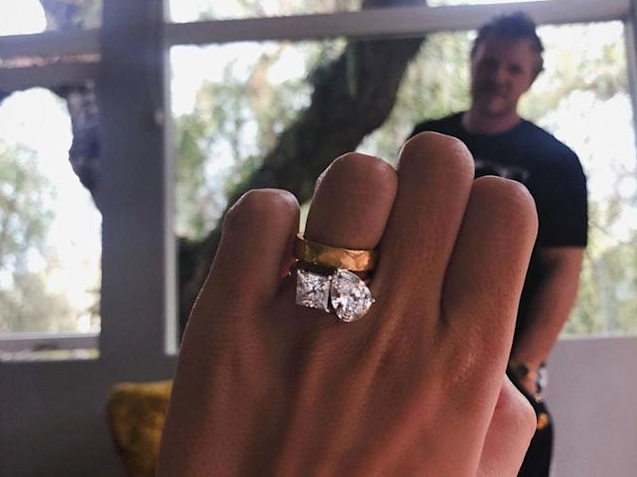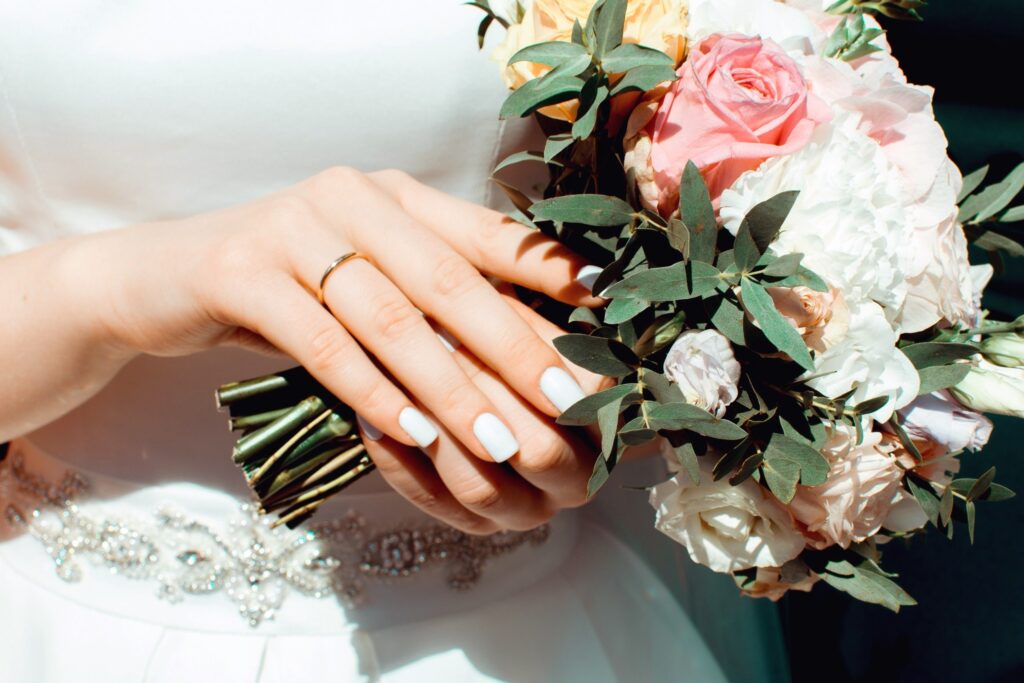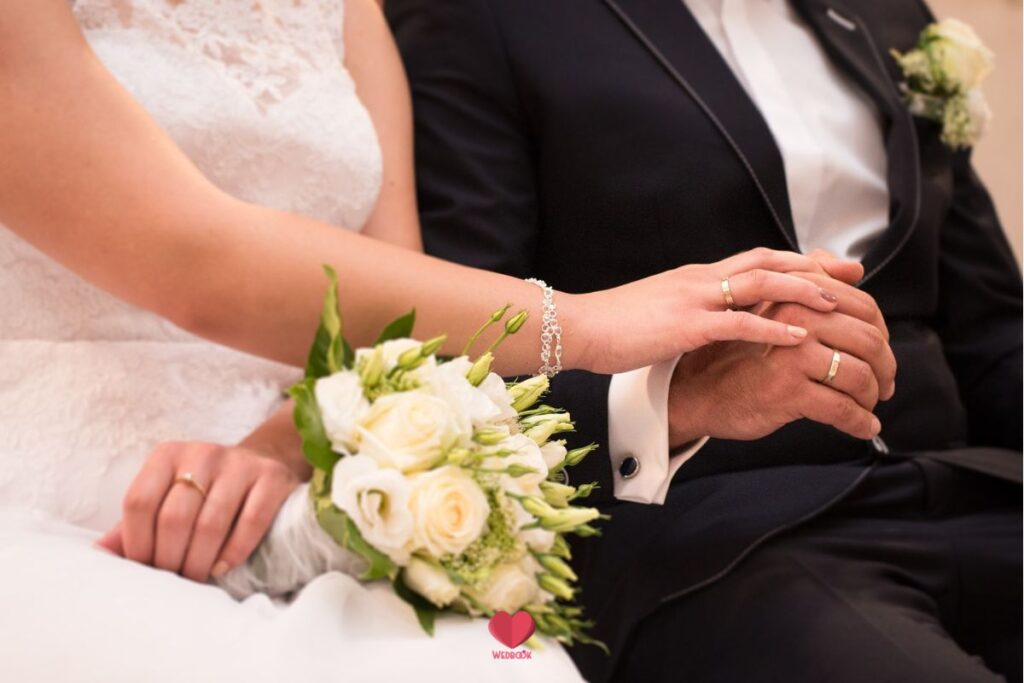You’ve been obsessed with your engagement ring since the time your fiance put it on your ring finger. You have spent hours staring at it and there are chances you’d never want to remove your precious bauble from your finger – flaunting it as much as you want. Especially on your wedding day – when every moment will be photographed and you’d want your sparkler to be the center of attention. But what about during the ceremony? When your partner is supposed to slip yet another ring on the same finger that’s meant to come before the engagement ring. What do you do with your engagement ring during the ceremony? Here are three options to this million-dollar question.
#1 Leave It Altogether
If you don’t want to worry about your engagement ring during the ceremony, you can leave it altogether. There are many reasons why a bride would want to opt for this option. The first reason is religious. It’s believed that when your partner puts the wedding band on your hand, you should only have that particular ring on your hand and nothing else. For those leaning toward religious ceremonies, this seems like the best option. Secondly, brides opt to leave their engagement ring at home – safe and sound – so their wedding rings get a chance to shine on the wedding day. Your sparkler has already received much attention during your engagement shoot and on your social media when you announced the good news, now it’s time for your wedding band to shine. Let it be the star of your wedding photos as the engagement ring lies safely at your home. Or, if that doesn’t seem like a good option. Have someone hold your engagement ring during the ceremony only to slip it on after exchanging vows.
Have Someone Hold Your Ring
Alternatively, you can entrust someone to hold your engagement ring during the wedding ceremony. It can be your maid of honor. Although there are good chances, hers or any other bridesmaid dresses aren’t designed with pockets to carry your engagement ring. In that case, you can entrust the best man or any other groomsmen to keep your ring with them. Give them a jewelry pouch or a ring box to safely keep the ring. Then, after the ceremony, you can ask them to slip you the ring slyly and you can wear it after exchanging the vows. So you will be photo-ready and there are no problems with the wedding timeline as well.
Another way to have someone hold your engagement ring during a ceremony is to have a family member look after it as you exchange your vows. Consider someone you’d want to feel special like your mother-in-law or a younger sister who wasn’t part of the bridesmaid group. They will feel quite involved and special on D-Day.
#2 Wear It On Your Right Hand
For those who have the same ring size on both hands, you’re in luck. Just simply put your engagement ring on your right hand whilst exchanging the vows and slip it on the top later on. This is the best option for when you want to include both of your baubles on the special hand without having to worry about them being with someone else. You can slip the engagement ring after the ceremony on top of the band afterward.
#3 Let It Be
This goes against the normal wedding tradition, but if you really want your engagement ring to be where it is throughout the wedding, you can just let it stay on your left-hand finger – where it’s supposed to be all your life. Your husband-to-be then slips the wedding band on top of your engagement ring and a quick readjustment after the ceremony is all that’s needed to rightfully arrange the rings. Do know some religious ceremonies don’t permit you to wear any ring on your hand? So be sure it’s okay if you’re leaning towards a more religious ceremony.
FAQs For Engagement Ring During Ceremony
Can You Use Your Engagement Ring As Your Wedding Band?
Putting the dilemma of what you should do with your engagement ring during the ceremony to rest, you can opt for the same ring for both uses. There are no official rules that the engagement ring can’t be the same as your wedding band. The only thing that should come into play when deciding this is the couple’s preferences. After all, you’re the one who’d be wearing those rings for the rest of your life. And there’s no doubt that safely keeping two rings is a more difficult task than keeping and maintaining one. Two-in-one bridal sets are also common these days. They give the appearance of a wedding band & an engagement ring but there’s only one ring to maintain. There’s no right or wrong to choose from here. It’s all about your personal preference.
Is It Bad Luck To Wear Your Engagement Ring On Your Wedding Day?
Absolutely not! Traditionally, you aren’t supposed to wear an engagement ring during the ceremony and are supposed to have bare hands when your husband-to-be slips the wedding band after exchanging vows. Naturally, if you are having a more religious approach to the ceremony, you’d be advised to not wear the engagement ring. Nonetheless, if you do decide to wear an engagement ring during the ceremony, it surely doesn’t mean that it’s bad luck or anything of that sort. There’s a traditional touch to not wearing the engagement ring on the wedding day, but that doesn’t have to do anything with bad luck. Don’t let anybody believe you otherwise.
Do You Wear Your Engagement Ring On Top Or Bottom?
Usually, the engagement ring goes on top of the wedding band. Many wedding bands also encircle the solitaire in the middle with a small curve to give it a halo ring appearance making it look bigger and more beautiful in appearance. Wedding bands are also designed to go below the engagement ring so you can easily remove the sparkler when it’s more prone to damage or you want a simpler approach to your outfit on a day.
Conventionally, it’s also believed that wedding bands are worn closer to the finger so it’s also closer to your heart (the vein of the ring finger is connected directly to the heart). Yet again, changing the order of rings also depends on your personal preference. Like model Emily Ratajkowski preferred to stack her golden wedding band atop her massive dual-diamond ring.

What’s The History & Significance Of Engagement Rings?
Engagement rings can be dated back to ancient Egypt, with ancient Greeks adopting the tradition. The tradition is also traced back to ancient Rome where it was adopted separately from these two cultures. In Egypt, the men would twist plants (mainly hemp and reed) to symbolize the upcoming union. They placed the ring on the fourth finger of the left hand because of its direct connection to the heart. The circle was chosen because of its representation of no end and no beginning, symbolizing eternity and dedication to a lifetime partnership. The circle also represented the shape of the Sun and the moon which the Egyptians worshiped. In Rome, you can find the reference to the first metal rings. The women in ancient Rome were presented with two rings – one of iron to wear every day at home and other of gold to wear for social representation in public.
It wasn’t until 850 that engagement rings were officially declared by Pope Nicholas I as a symbol of a man’s intent to marry a woman. The first account of diamond rings can be traced to 1477 when Archduke Maximillian of Austria gave Mary of Burgundy a diamond ring to signify their betrothed status. As the wealthy traveled, the trend of diamond rings spread across the upper class of Europe. However, diamond engagement rings didn’t gain as much popularity as they are today until the De Beers “A Diamond Is Forever” marketing campaign in 1947. Before that, diamond engagement rings only constituted 10% of the total engagement rings in America. Before diamond engagement rings became popular, many other rings like the gimmel rings and poesy rings also occupied the market of betrothal rings in & around Europe, and the rest of the world as a result of colonization.
While the De Beers “A Diamond Is Forever” campaign is to be attributed to the diamond rush in the betrothal, there were several other pushes to make diamond a valuable stone – one of them being Kohi-noor being embellished in Queen Victoria’s crown. The engagement rings became primarily of diamonds in the second half of the 20th century, with De Beers controlling around 90% of the world’s production of the rough diamonds through their cartels in South Africa. It was only in 2000 that their share went as low as 30% after negative publicity surrounding blood diamonds, greater transparency, and a more competitive diamond market. Today, engagement rings are 87% diamond rings with 43% of buyers wanting a round cut and the average size of the solitaire is 1.3 carats.
What’s The History & Significance Of Wedding Bands?
The wedding band evolved right alongside engagement rings as a simpler option to engagement rings to wear every day or for a second ring to place during the actual ceremony. The bands also became popular during World War times when soldiers gave their partners a band as a promise to come back and marry them. This was also around the time when it became popular for men to wear wedding bands to remember their partners or wives back home. After that, the trend caught among civilians as well. Now, the wedding bands are worn by both partners as part of their commitment to each other.
Who Buys The Wedding Rings?
The wedding rings are born by the other partner or their families. Unlike the engagement ring which is to be only purchased by the men or can be a family heirloom, the wedding bands are purchased by both parties or their families.
Conclusion:

In conclusion and to answer your question about what to do with your engagement ring during the ceremony, there are 3 main solutions to look at! Leave it at home or have someone responsible hold it for you whilst exchanging vows only to slip it on later, let it stay on your left hand and adjust it later, or wear it on your right hand or any other finger. What you choose depends on your personal preference, just like any other wedding decision you make.





